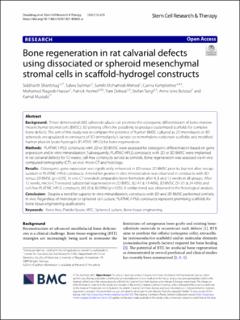| dc.contributor.author | Shanbhag, Siddharth | |
| dc.contributor.author | Suliman, Salwa | |
| dc.contributor.author | Mohamed-Ahmed, Samih Salah Eldin Mahgoub | |
| dc.contributor.author | Kampleitner, Carina | |
| dc.contributor.author | Hassan, Mohamed Nageeb | |
| dc.contributor.author | Heimel, Patrick | |
| dc.contributor.author | Dobsak, Toni | |
| dc.contributor.author | Tangl, Stefan | |
| dc.contributor.author | Bolstad, Anne Isine | |
| dc.contributor.author | Mustafa, Kamal Babikeir Elnour | |
| dc.date.accessioned | 2022-04-21T13:18:05Z | |
| dc.date.available | 2022-04-21T13:18:05Z | |
| dc.date.created | 2021-11-25T11:52:47Z | |
| dc.date.issued | 2021 | |
| dc.identifier.issn | 1757-6512 | |
| dc.identifier.uri | https://hdl.handle.net/11250/2992068 | |
| dc.description.abstract | Background
Three-dimensional (3D) spheroid culture can promote the osteogenic differentiation of bone marrow mesenchymal stromal cells (BMSC). 3D printing offers the possibility to produce customized scaffolds for complex bone defects. The aim of this study was to compare the potential of human BMSC cultured as 2D monolayers or 3D spheroids encapsulated in constructs of 3D-printed poly-L-lactide-co-trimethylene carbonate scaffolds and modified human platelet lysate hydrogels (PLATMC-HPLG) for bone regeneration.
Methods
PLATMC-HPLG constructs with 2D or 3D BMSC were assessed for osteogenic differentiation based on gene expression and in vitro mineralization. Subsequently, PLATMC-HPLG constructs with 2D or 3D BMSC were implanted in rat calvarial defects for 12 weeks; cell-free constructs served as controls. Bone regeneration was assessed via in vivo computed tomography (CT), ex vivo micro-CT and histology.
Results
Osteogenic gene expression was significantly enhanced in 3D versus 2D BMSC prior to, but not after, encapsulation in PLATMC-HPLG constructs. A trend for greater in vitro mineralization was observed in constructs with 3D versus 2D BMSC (p > 0.05). In vivo CT revealed comparable bone formation after 4, 8 and 12 weeks in all groups. After 12 weeks, micro-CT revealed substantial regeneration in 2D BMSC (62.47 ± 19.46%), 3D BMSC (51.01 ± 24.43%) and cell-free PLATMC-HPLG constructs (43.20 ± 30.09%) (p > 0.05). A similar trend was observed in the histological analysis.
Conclusion
Despite a trend for superior in vitro mineralization, constructs with 3D and 2D BMSC performed similarly in vivo. Regardless of monolayer or spheroid cell culture, PLATMC-HPLG constructs represent promising scaffolds for bone tissue engineering applications. | en_US |
| dc.language.iso | eng | en_US |
| dc.publisher | BMC | en_US |
| dc.rights | Navngivelse 4.0 Internasjonal | * |
| dc.rights.uri | http://creativecommons.org/licenses/by/4.0/deed.no | * |
| dc.title | Bone regeneration in rat calvarial defects using dissociated or spheroid mesenchymal stromal cells in scaffold-hydrogel constructs | en_US |
| dc.type | Journal article | en_US |
| dc.type | Peer reviewed | en_US |
| dc.description.version | publishedVersion | en_US |
| dc.rights.holder | Copyright The Author(s) 2021 | en_US |
| dc.source.articlenumber | 575 | en_US |
| cristin.ispublished | true | |
| cristin.fulltext | original | |
| cristin.qualitycode | 1 | |
| dc.identifier.doi | 10.1186/s13287-021-02642-w | |
| dc.identifier.cristin | 1958955 | |
| dc.source.journal | Stem Cell Research & Therapy | en_US |
| dc.identifier.citation | Stem Cell Research & Therapy. 2021, 12, 575. | en_US |
| dc.source.volume | 12 | en_US |

